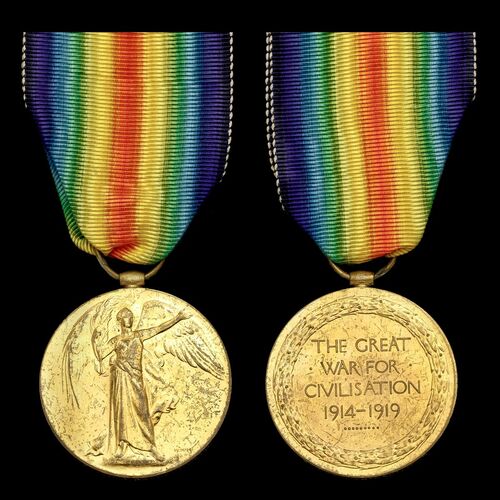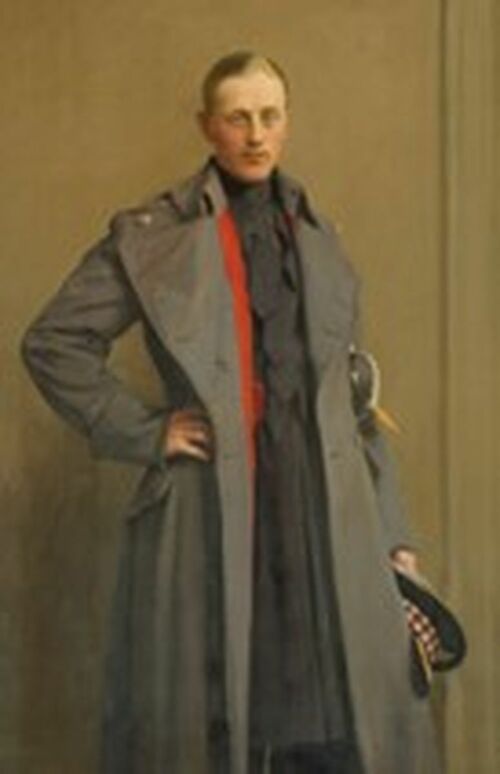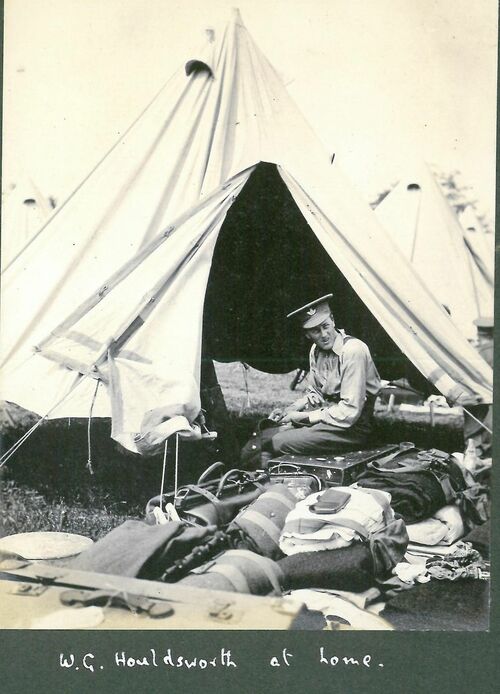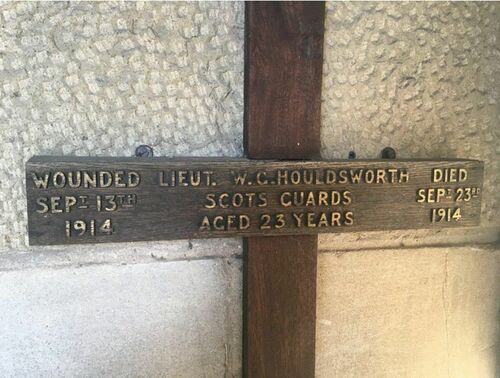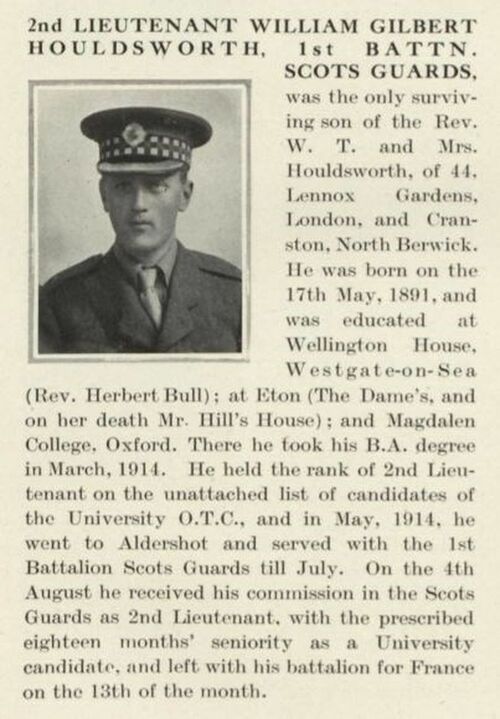Auction: 23113 - Orders, Decorations and Medals - e-Auction
Lot: 185
The Victory Medal awarded to Lieutenant W. G. Houldsworth, 1st Battalion, Scots Guards, who was mortally wounded on 13 September 1914 during the Battle of the Aisne, succumbing to his wounds ten days later
Victory Medal 1914-19 (Lieut. W. G. Houldsworth.), good very fine
William Gilbert Houldsworth was born on 17 May 1891 at London. He was educated Wellington House Preparatory School, Westgate-on-Sea, Thanet and Eton College from 1904-09. He then went up to Oxford and matriculated at Magdalen College as a Commoner on 18 October 1910, having taken Responsions in Michaelmas Term 1909. He took the First Public Examination in the Hilary and Trinity Terms of 1911 and then read for a Pass Degree (Groups A1 [Greek and/or Latin Literature/Philosophy], E1 [The Elements of Military History and Strategy]), and acquired an additional Certificate in Tacitus. He was awarded his Degree in 1913 and took his BA on 12 March 1914 alongside C.R. Priest. A keen sportsman, a good horseman and a powerful golfer, he was a member of the Bachelor’s and Conservative Clubs, London, and of the New and Tantallon Clubs, North Berwick. When making his will, he gave his address as 44, Lennox Gardens, Middlesex. His University website gives more detail:
'Houldsworth joined the Oxford University Officers’ Training Corps (OUOTC) during his first term at Magdalen and on 1 July 1912 was commissioned as Second Lieutenant on probation on the unattached list of candidates in the OUOTC. On graduating from Oxford in 1913, he joined the Scots Guards, and from 6 May to 15 July 1914 he was stationed at Aldershot, serving in the Regiment’s 1st Battalion alongside Inigo-Jones and Graham Menzies. On 14 August 1914 he was confirmed in the rank of Second Lieutenant (with eighteen months seniority as a University Candidate) and in September 1914, not long before his death, he was promoted Lieutenant because of that seniority.
The Battalion left Aldershot, Hampshire, for Southampton on 13 August 1914 and reached Le Havre on 15 August. It entrained later on the same day, and travelling north-westwards via Rouen, Amiens, Arras and Cambrai, arrived at le-Nouvion-en-Thiérache on 16 August. From here it marched for five days, first north-east to Cartignies (21 August) and thence to the Belgian border, which it crossed on 22 August, arriving at Grand Reng on the following day. Here, as part of the 1st Guards Brigade, 1st Division, it was on the extreme right of I Corps, next to the French 5th Army. The German attack southwards from Belgium into France towards Paris began on 23 August, and on the following day the Battalion began its long withdrawal south-south-westwards for ten days, sometimes marching for 30 miles in a day in very hot and trying conditions, until it reached Chambry on 2 September, where, as part of the 1st Division’s rear-guard, it covered the 1st Division’s crossing of the Grand Morin river at Coulommiers. On 3 September the Battalion crossed the Marne at Germigny; on 4 September it reached Coulommiers; and on 5 September it halted at the village of Nesles, just north of Rozay-en-Brie, where its retreat from Mons came to an end. From 6 to 9 September 1914, the Battalion took part in the general advance north-eastwards: it crossed the River Marne at Nogent l’Artaud on 9 September, and from there it went to Bazoches-sur-Vesles (12 September) before crossing the River Aisne, the Aisne Canal and the Aisne et Oise Canal on 13 September, the beginning of the Battle of the Aisne.
On the same day Houldsworth’s father wrote a letter to President Warren in which he said:
“[Ralph Gibbs (see above)] was one of my boy’s closest friends. Their devotion to each other is strongly cemented & they are intensely happy. Oxford must present a strange Contrast to what it has been & a very depressing contrast – I suppose you watch all these young lives with the probability of their going to the front as soon as they are allowed – & keen to get there. Well, it will make men of them earlier than in the past.”
But on that very day, Houldsworth was severely wounded in the head by long-range artillery fire near Paissy, a tiny village just south of the eastern end of the Chemin des Dames (see G.M.R. Turbutt), one of the Battalion’s 17 casualties killed, wounded and missing on that day. He died of wounds received in action on 23 September 1914, aged 23, in the American Hospital, Neuilly-sur-Seine, Paris. He is commemorated on monuments in St Andrew’s Church, Wells St, London W1 and St Peter’s Church, Eaton Square, Belgravia, London SW1.'
St Baldred’s Church, Dirleton Ave., North Berwick, East Lothian has his original wooden cross on display, whilst in 1923 his mother commissioned a posthumous portrait from Spencer Watson in 1924 in memory of her only son, with Houldsworth's cousin standing in as the model. That portrait was sold at Christie's in 2020 (https://onlineonly.christies.com/s/british-european-art/george-spencer-watson-r-a-r-w-s-r-o-i-british-1869-1934-17/92209#:~:text=One%20of%20the%20first%20soldiers,23%20September%201914%20in%20France).
Subject to 20% VAT on Buyer’s Premium. For more information please view Terms and Conditions for Buyers.
Sold for
£270
Starting price
£70

